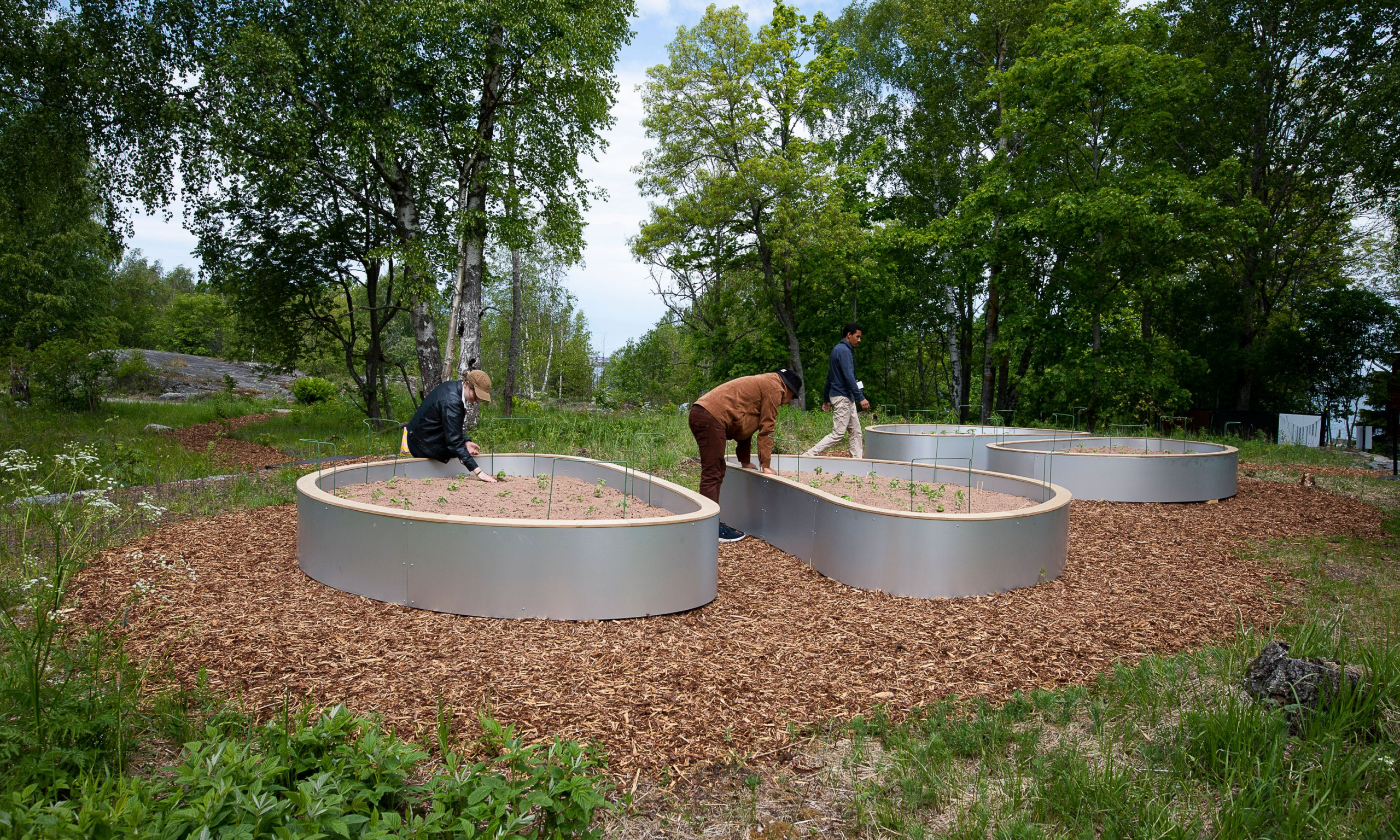Installation by PHOsfate (Mohamed Sleiman Labat and Pekka Niskanen) on Vallisaari island in Helsinki Courtesy of HAM, Helsinki Biennial and Sonja Hyytiäinen
The second Helsinki Biennial, which launched last week (until 17 September), highlights the ongoing issue of sustainability in the art world. Exhibition sites include the Helsinki Art Museum and the island of Vallisaari, a 20-minute ferry ride from the capital.
The biennial, which includes works by 29 artists and artist collectives, takes its title, New Directions May Emerge, from a quote by the US anthropologist Anna Lowenhaupt Tsing who said: “As contamination changes world-making projects, mutual worlds—and new directions—may emerge.”
The curatorial concept expands on the issue of contamination, focusing how “on the island of Vallisaari, there are contradictions at play—the island’s unique biodiversity and its environmentally protected status [are] set against the remains of military contamination (gunpowder magazines),” writes the curator Joasia Krysa, professor of exhibition research and head of art and design at Liverpool John Moores University, in the catalogue introduction.
The Finnish artist Tuula Närhinen has created one of the most prescient pieces in the biennial, The Plastic Horizon (2019-23), comprising plastic debris such as toys, bottle caps and plastic-coated tubes used in mining and construction site blasting operations, collected over the years from the seashores of Helsinki.
“I believe that both my works, the Deep Time Deposits at Helsinki Art Museum and The Plastic Horizon on Vallisaari Island contribute to a larger discussion about the intertwinement between urban life and the bodies of water that surround us,” she tells The Art Newspaper. For the past 20 years, she has monitored the Baltic Sea from her studio located on Harakka Island.
“Compelling political and technological issues related to infrastructures, land use and trade are at stake when a city, such as Helsinki keeps growing and expands towards the sea by merging the nearby islands to mainland using filling earth and blasting the bedrock,” she adds.
TBA21-Academy in Venice, the ecologically minded offshoot of the contemporary art foundation TBA21 (Thyssen-Bornemisza Art Contemporary), is a co-commissioning partner, jointly producing two works in the biennial: Hypoxia (2023) by the Lithuanian artist Emilija Skarnulyte and Oikos (2023) by the Sámi artist Matti Aikio. The latter’s multi-channel video on Vallisaari looks at how humans interact with animals, also addressing “conflicts around the use of natural resources, nature conservation [and] fossil-free energy”, according to a project statement.
“Despite the multiple angles and vantage points, I believe there is an extraordinary level of cohesion across the [biennial] works,” says Markus Reymann, the director of the TBA21-Academy.
The bigger issue here, however, is whether biennials can ever be sustainable in light of the sheer volume of works, and people, on the move. “Emerging from the pandemic, we were forced to reflect and revalue on how we live and our impact on this planet,” Krysa says. “Think about the art world; there are around 300 biennials annually. This is not the most sustainable model. We need to start to reflect on this.”
Reymann says: “Obviously parts can be controlled [and sustainable] like the use of materials, energy and making sure that travel is planned around multiple engagements in a city or country, rather than just showing up for an opening or a talk.”
The co-commissioned works will travel post biennial with the smallest carbon footprint possible, he adds. “The fact that parts of the biennial are installed in the climate-controlled rooms of the Helsinki Art Museum and other parts are shown on an island which is only accessible by boat come with a carbon footprint. On the other hand, the island and structures on it are highly environmentally regulated.”
“In the bigger picture, I’m afraid that no human activity of this scale can ever be described as sustainable. However, every individual, including the participating artists can take responsibility of their own actions even if the effort may seem unimportant,” says Närhinen, pointing to how her piece Deep Time Deposits—a record of the tides of the River Thames over 34 days—can be packed in three cases.
“This is how the work travelled from London to Helsinki piled on just one pallet. It may sound like small potatoes, but personally I find solace in trying to make things happen as feasibly and economically as possible,” she says.
Other highlights include a series of sculptures by the Argentine artist Adrián Villar Rojas generated via an amalgamation of software systems known as the Time Engine (The End of Imagination, 2023). The works, camouflaged amongst the shrubbery of Vallisaari island, reflect the “perishing materiality” of existence, according to the catalogue, accentuating the temporary nature of human civilisation.
The work most attuned to the island is a garden installation by the artist duo PHOsfate (Mohamed Sleiman Labat and Pekka Niskanen) who concentrate on environmental issues such as ocean eutrophication—when nutrients from agricultural, industrial and urban wastes enter the seas, leading to the disruption of marine ecosystems. The water-preserving sandoponic gardens installed on Vallisaari are used for growing potatoes, kale and salad.

